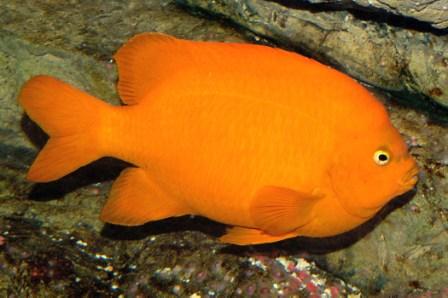
Photo credit: Cabrillo Marine Aquarium / Gary Florin
Underwater photos of California’s coast featured in books and magazines almost always showcase a certain fish: the garibaldi. The brilliant orange coloring of the garibaldi is a must have in any underwater shot because this fish dazzles the eyes and brings California’s ocean landscape to life in the same way brightly colored coral reef fish win admirers across the globe.
Garibaldi or Hypsypops rubicunda are shaped like most fish except for carrying more height throughout the middle of their body leading to a steeply sloping forehead, which angles into bright orange lips. According to Dr. Love’s book Probably More Than you Want to Know About the Fishes of the Pacific Coast, the first part of the scientific name “Hypsypops comes from three Greek words which mean ‘high below the eye.’”
Love’s take is that this refers to “the wide distance from the front of the head to the eye,” which kind of makes sense. But the name might refer to the garibaldi’s equally tall body below their bright gold eyes since they are a bit rectangular in shape compared to most fish. And if you were hoping for clarity in the second part of the name, rubicunda, you are out of luck because that is derived from Latin for red and the garibaldi is orange.
The garibaldi suffers from human color blindness all around since the common name refers to the Italian revolutionary Giuseppe Garibaldi who is famous for wearing a bright red shirt. Once again the garibaldi is not red.
This radiant orange fish can grow to be up to 14 inches in length and can live to be 17 years old. Males and females look exactly alike, but when it comes to the gender roles they play below the surface males and females are anything but similar.
To get ready for breeding season in spring, male garibaldi start building nests in separate territories. No that’s not a typo, the males are the nest makers and keepers. They usually choose a prime piece of real estate in a rocky reef area on the ocean floor and start clearing out all debris by picking it up with their mouths and carrying it away, including sea stars, rocks, shells, you name it.
Nest cleaning time is when the male garibaldi’s version of obsessive compulsive disorder sets in and remains strong throughout the duration of breeding season. Once the nest area is spotless, the male lines it with red algae and then begins to guard the newly tidied area while waiting for the first female to arrive.
Mike Schaadt, Director of Cabrillo Marine Aquarium (CMA), has been observing garibaldi for years and once had the chance to observe a female visit a nest in Eagle Reef near Catalina. “The female came down and she put her vent near her anus, which is where the eggs come out and put it right up against the carpet of red algae,” said Schaadt.
The male fidgets nervously about the nest waiting for the female to finish laying eggs. “Once she’s done making her passes, he goes over and shoos her away,” said Schaadt. “One minute he’s kind of enticing her in, is this a good looking nest to you? She chooses it, lays her eggs and then it’s a complete turnaround, get out of here!”
Of course the female takes off because who wants to put up with that? “Then he makes a couple passes where he releases his sperm, again coming out near the vent,” said Schaadt. “He kind of quivers over the nest, then he swims around it and then he guards it. And that’s his job for the next 10 to 12 days.”
This is a full-time job since the ocean is a dangerous place full of bigger animals of all types, but that doesn’t stop the male garibaldi from strictly patrolling his nest. He furiously defends it and often successfully chases much larger animals away.
Schaadt has been on the receiving end of a male garibaldi’s ire. For nine years as part of the aquarium’s research, Schaadt swam out to a male garibaldi’s nest three to five times a week around noon. “He saw me a lot and when I got there he would be right at the nest and I could see him from the surface when the water was clear,” said Schaadt. “I could tell he was looking up at me and then as I swam down he got more nervous, well nervous is a human trait, but he was really getting much more active around the nest.”
“Then as I got closer and closer he would thump at me and as I was going back up I could hear him thumping back at me. Other people that have watched actually saw him follow me up a bit to make sure that I got to the surface away from his nest.”
The thumping noise Schaadt describes is the garibaldi version of yelling. By rubbing their throat teeth together, males create a walloping sound to scare off intruders. And despite the vast size difference they aren’t afraid to bite humans either. Schaadt has been a victim of garibaldi teeth. (stay tuned for part 2 tomorrow)
More fun fish facts for fodder! And named after an Italian military man. How many other fish can claim that. I take it there isn’t a Mussolini fish.